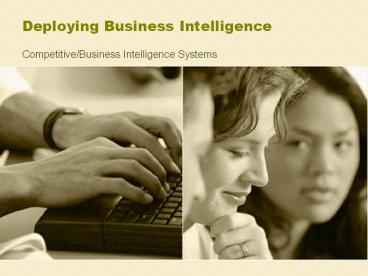Deploying Business Intelligence - PowerPoint PPT Presentation
1 / 14
Title:
Deploying Business Intelligence
Description:
... profits Risk Management Activity Based Costing Logistics Customer Relationships Sales forecasting Segmentation Cross-selling CRM analysis Campaign planning ... – PowerPoint PPT presentation
Number of Views:42
Avg rating:3.0/5.0
Title: Deploying Business Intelligence
1
Deploying Business Intelligence
- Competitive/Business Intelligence Systems
2
What is BI?
- Transforming disparate data into information that
is accessible, timely, meaningful, actionable - BI is synonymous with past applications
- Decision Support Systems (DSS)
- Executive Information Systems (EIS)
- Multidimensional modeling (E.F. Codd circa 1990s)
3
BI is an Iterative Process
4
What Questions can BI answer?
- Where are we?
- What were our sales this month?
- Where are we going?
- Are our sales trending up or down?
- Why is this happening?
- Why are sales going down?
- What is going to happen in the future?
- Forecasting / What If analysis
- How can I plan for the future?
- Planning / Goal Setting
5
Where is BI utilized?
- Operations
- ERP Reporting/Analysis
- KPI tracking
- Maximizing profits
- Risk Management
- Activity Based Costing
- Logistics
- Customer Relationships
- Sales forecasting
- Segmentation
- Cross-selling
- CRM analysis
- Campaign planning
- Customer profitability
6
Major BI/OLAP Vendors
- Oracle OLAP
- SAP BW
- MS-SQL Server Analysis Services
- Hyperion Essbase/IBM
- Microstrategy
- Business Objects
- IBM-COGNOS
7
Current State of BI Industry
- Microsoft has entered the market
- ERP vendors are offering BI tools
- Web deployment is CSF for all BI vendors
- However,
- Successful BI deployment requires collaboration
between IT business users - Most BI deployment problems revolve around people
process issues not tool selected
8
BI Design Considerations
- Project Scope (phased approaches typically fare
better than massive scale) - Buy-in must exist on the part of IT business
- Design must be focused on needs of business users
- User expectations must be managed
9
BI Design Considerations (cont.)
- Source data
- Does access to data exist?
- How many sources/what platform types of data
exist? - Does BI initiative include DW?
- What data definition issues exist?
- What data cleansing / transformation issues
exist? - Who is responsible for cleansing / transforming
data to useable state?
10
BI Design Considerations (cont.)
- Reporting vs. Analysis Needs
- Entirely different functions
- Each involves different user audience
- Each requires different BI tool
- Each requires different source data
- Each requires different design approach
11
BI Design Considerations (cont.)
- OLAP / Multidimensional Cubes
- How many to build?
- What should be included in each? (breadth
depth) - Who will receive?
- What security levels should exist?
- What are cube update considerations? (when, how
frequent, time length of update) - What are end-user performance issues?
- What is process for modifying / augmenting cubes?
12
BI Design Considerations (cont.)
- Other OLAP Considerations
- What dimensions? How many?
- What time dimensions?
- What levels in hierarchies?
- What measures? How many?
- What pre-built calculations and/or summaries
should be created?
13
The Business Case for BI
- Above all else, BI must have a strong business
case to succeed. Business Case must show that - BI can deliver high business value to involved
stakeholders - Benefit of BI can cross functional boundaries
- Benefit of BI can cross organizational boundaries
- BI can offer measurable short term ROI, as well
as long-term ROI
14
The End.































